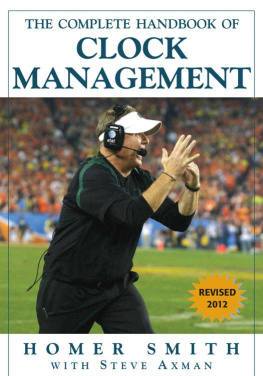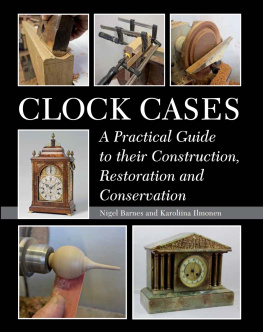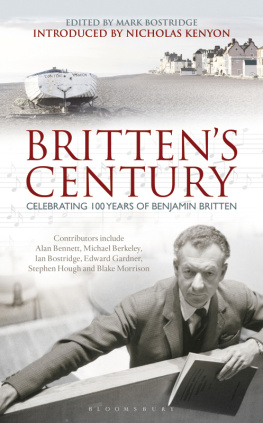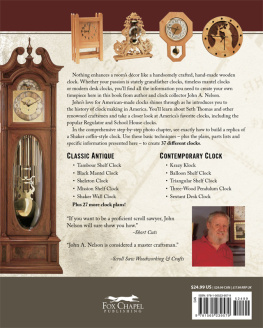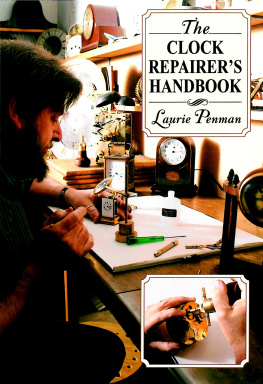The Watch and Clock Makers' Handbook, Dictionary, and Guide
F.J. Britten
Editorial notes and editing copyright 2011 by Skyhorse Publishing, Inc.
All Rights Reserved. No part of this book may be reproduced in any manner without the express written consent of the publisher, except in the case of brief excerpts in critical reviews or articles. All inquiries should be addressed to Skyhorse Publishing, West 36th Street, 11th Floor, New York, NY 10018.
Skyhorse Publishing books may be purchased in bulk at special discounts for sales promotion, corporate gifts, fund-raising, or educational purposes. Special editions can also be created to specifications. For details, contact the Special Sales Department, Skyhorse Publishing, West 36th Street, 11th Floor, New York, NY 10018 or info@skyhorsepublishing.com.
and Skyhorse are registered trademarks of Skyhorse Publishing, a Delaware corporation.
www.skyhorsepublishing.com
10987654321
Library of Congress Cataloging-in-Publication Data
Britten, F.J. (Frederick James), 1843-1913.
The watch and clock makers handbook, dictionary, and guide / by F.J. Britten.
p. cm.
Previously published: Woodbridge, Suffolk, England: Antique Collectors Club, 1988.
9781616082055
Clocks and watches. I. Title.
TS545.B87 2011
681.114--dc22
2010040774
Printed in Canada
Table of Contents
Title Page
Copyright Page
PREFACE
THE WATCH & CLOCK MAKERS HANDBOOK, - DICTIONARY, AND
APPENDIX.
ALSO AVAILABLE
ALSO AVAILABLE
ALSO AVAILABLE
PREFACE
In compliance with suggestions from readers of previous issues, various additions have now been made. In particular, the description of the Westminster great clock is given in greater detail. Probably the death of Lord Grimthorpe awakened renewed interest in his work, for I received several letters asking for more minute particulars.
Alterations have been made in the German equivalents on the recommendation of Mr. Heinrich Otto, who has, in addition, entirely revised the German List in the Appendix. I have also to thank Mr. Otto for corrections relating to other matters in the book. The French equivalents remain as originally furnished by Mr. Mairet.
On many occasions I have been asked to give readers some instructions respecting mechanical drawing, but really there is so little to tell. The art of watch or clock making cannot be learnt from books alone, there must be much practice if one desires to excel, and so it is with mechanical drawing. Nothing will so much assist the learner to understand the functions of a machine and of its different parts as drawing to scale, and if he has what I will venture to call the instinct of the mechanician, proficiency will come with practice.
The young draughtsman should be provided with a drawing board and tee square of half-imperial size, half-a-dozen drawing pins, drawing paper, an H. and an H.B. pencil, a and a set square, a good set of compasses jointed in both legs, ink and pencil bows for small circles, a ruling pen, a four-inch protractor of thin horn, a box-wood scale divided on both sides and both edges, a piece of india-rubber, two or three pallets, and either a large stick of Chinese ink or a bottle of fluid Indian ink, but not a horn centre.
For an intricate drawing the paper is best damped and fixed to the board by gluing a narrow margin all round the edge, but it is generally sufficiently secured by a pin at each corner. Care should be taken to press the pins down so that the heads clasp the paper, otherwise the least disturbance from cleaning with rubber will cause the paper to shift. The H pencil should be sharpened to a chisel-shaped edge, so as to get the full width of the lead in drawing. Keep the stock of the square close to the edge of the board with the left hand, and hold the pencil quite upright and low enough to allow the little finger of the right hand to slide along the blade of the square as you draw the line, so that if the blade is a little warped you ensure its contact with the paper. See that the central point of the compasses is sharp, and, in using the compasses, bear very lightly, turning always the same way. Keep the central leg upright, bending the joint for every different size of circle, for if the point describes a cone it will be impossible to keep the prick point in the paper small. Ink in curves and circles before straight lines, beginning with those of least radius.
Several correspondents have suggested that fuller particulars of eminent members of the craft would be of interest. But I found it would be inconvenient to include such biographical sketches, together with descriptions of early timekeepers, in a book intended primarily for workshop use, and so I was led to issue a separate volume; and I refer those who take special interest in the history of horological instruments to OLD CLOCKS AND WATCHES AND THEIR MAKERS, with which is incorporated a List of Former Craftsmen.
In this edition of the Handbook the remarks on Watch Springing have been extended to suit especially the needs of those who do such work occasionally. For a more comprehensive study of the subject is recommended a book entitled, WATCH SPRINGING AND ADJUSTING.
I have received so many appreciative letters, that I venture to ask those who think well of my books to favour me by recommending them as opportunity occurs.
F. J. B.
I, Silverdale Avenue,
Westcliff-on-Sea, Essex.
1907.
Mr. F. J. Britten died on April, 1913.
The edition was reprinted January, 1915, with one or two slight corrections and additions.
At my request Mr. Otto has kindly revised the whole of the German equivalents, for which I tender him my thanks.
My thanks are also due to Mr. James Savidge, Secretary of the British Horological Institute. who has given me great assistance in putting the book to press.
A. M. BRITTEN.
THE WATCH & CLOCK MAKERS HANDBOOK,
DICTIONARY, AND
NOTEFrench and German equivalents, printed in refer to the first definition in cases where the title has more than one meaning.
natrliche Gangbeschleunigung .]Gaining on its rate. It is noticed that new chronometers and watches, instead of steadily gaining or losing a certain number of seconds each day, go faster day after day. There is no certainty as to the amount or ratio of this acceleration, nor as to the period which must elapse before the rate becomes steady, but an increase of a second a month for a twelvemonth may be taken as the average extent in marine chronometers.
It is pretty generally agreed among chronometer-makers that the cause of acceleration is seated in the balance-spring, though some assert that centrifugal action slightly enlarges the balance if the arc of vibration is large, as it would be when the oil is fresh, and that as the vibration falls off, centrifugal action is lessened and acceleration ensues from the smaller diameter of the balance. Though the balances do undoubtedly increase slightly in size in the long vibrations from centrifugal action, this theory is disposed of by the fact that old chronometers do not accelerate after re-oiling. Others aver that the unnatural connection of the metals composing the compensation balance is responsible for the mischief, and that after being subjected to heat the balance hardly returns to its original position again. If true, this may be a reason for exposing new chronometers before they are rated to a somewhat higher temperature than they are likely to meet with in use, as is the practice of some makers ; but then chronometers accelerate on their rates when they are kept in a constant temperature, and also if a new spring is put to an old balance, or even if a plain uncut balance is used.



